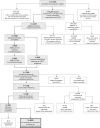Three-year course of clinical high-risk symptoms for psychosis in the community: a latent class analysis
- PMID: 39801353
- PMCID: PMC11735126
- DOI: 10.1017/S2045796024000891
Three-year course of clinical high-risk symptoms for psychosis in the community: a latent class analysis
Abstract
Aims: Clinical high-risk for psychosis (CHR-P) states exhibit diverse clinical presentations, prompting a shift towards broader outcome assessments beyond psychosis manifestation. To elucidate more uniform clinical profiles and their trajectories, we investigated CHR-P profiles in a community sample.
Methods: Participants (N = 829; baseline age: 16-40 years) comprised individuals from a Swiss community sample who were followed up over roughly 3 years. latent class analysis was applied to CHR-P symptom data at baseline and follow-up, and classes were examined for demographic and clinical differences, as well as stability over time.
Results: Similar three-class solutions were yielded for both time points. Class 1 was mainly characterized by subtle, subjectively experienced disturbances in mental processes, including thinking, speech and perception (basic symptoms [BSs]). Class 2 was characterized by subthreshold positive psychotic symptoms (i.e., mild delusions or hallucinations) indicative of an ultra-high risk for psychosis. Class 3, the largest group (comprising over 90% of participants), exhibited the lowest probability of experiencing any psychosis-related symptoms (CHR-P symptoms). Classes 1 and 2 included more participants with functional impairment and psychiatric morbidity. Class 3 participants had a low probability of having functional deficits or mental disorders at both time points, suggesting that Class 3 was the healthiest group and that their mental health and functioning remained stable throughout the study period. While 91% of Baseline Class 3 participants remained in their class over time, most Baseline Classes 1 (74%) and Class 2 (88%) participants moved to Follow-up Class 3.
Conclusions: Despite some temporal fluctuations, CHR-P symptoms within community samples cluster into distinct subgroups, reflecting varying levels of symptom severity and risk profiles. This clustering highlights the largely distinct nature of BSs and attenuated positive symptoms within the community. The association of Classes 1 and 2 with Axis-I disorders and functional deficits emphasizes the clinical significance of CHR-P symptoms. These findings highlight the need for personalized preventive measures targeting specific risk profiles in community-based populations.
Keywords: clinical profiles; community; course; general population; latent class analysis; movement; outcome; psychosis risk.
Conflict of interest statement
Drs. Michel, Kindler, and Schultze-Lutter as well as Mr. Osman (M.sc.) and Mrs. Rinaldi (M.Sc.) have declared that they have no conflicts of interest in relation to the subject of this study.
Dr. Schimmelmann has been a consultant and/or advisor to, or has received honoraria from AstraZeneca, Bristol-Myers Squibb, Eli Lilly, Janssen, Novartis, and Shire.
Figures
References
-
- Addington J, Stowkowy J, Liu L, Cadenhead KS, Cannon TD, Cornblatt BA, McGlashan TH, Perkins DO, Seidman LJ, Tsuang MT, Walker EF, Bearden CE, Mathalon DH, Santesteban-Echarri O and Woods SW (2019) Clinical and functional characteristics of youth at clinical high-risk for psychosis who do not transition to psychosis. Psychological Medicine 49, 1670–1677. - PubMed
-
- American Psychiatric Association (APA) (1994) Diagnostic and Statistical Manual of Mental Disorders. 4th. Washington, USA: APA.
-
- Beck K, Andreou C, Studerus E, Heitz U, Ittig S, Leanza L and Riecher-Rössler A (2019) Clinical and functional long-term outcome of patients at clinical high risk (CHR) for psychosis without transition to psychosis: A systematic review. Schizophrenia Research 210, 39–47. - PubMed
-
- Bergé D, Carter CS and Smucny J (2024) Identification of distinct clinical profiles and trajectories in individuals at high risk of developing psychosis: A latent profile analysis of the north American prodrome longitudinal study consortium-3 dataset. Early Intervention in Psychiatry 18, 739–749. - PMC - PubMed




